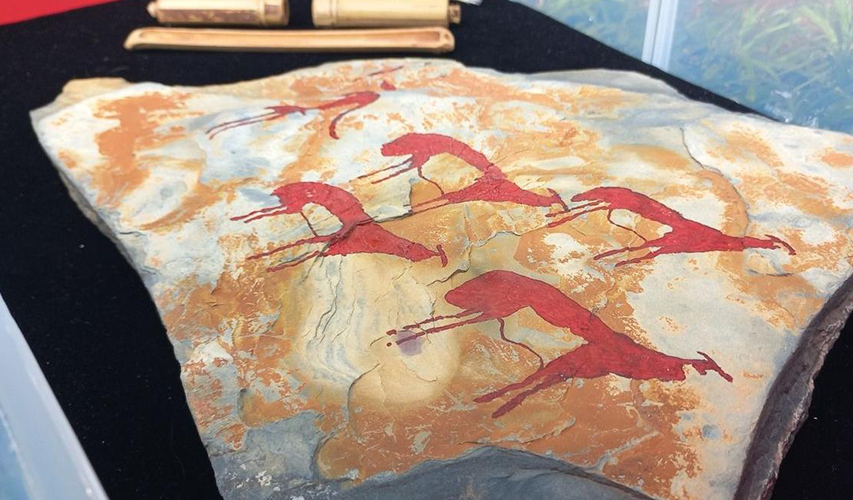With a rich academic background from institutions such as the University of Pretoria and the University of the Witwatersrand, Dr Forssman brings a wealth of experience to his role as a recipient of the National Research Foundation's African Origins Platform Grant, his research delves into forager technologies, innovations, and indigenous knowledge systems during the rise of the Mapungubwe state.
One of the pioneering initiatives under Dr Forssman's leadership is the Travelling Museum, an interactive and mobile display integral to the HARP Project, an interactive, mobile display that promotes archaeology, and our research into hunter-gatherers, and creates a unique engagement opportunity.
The museum accompanies us to talks, presentations, and visits, and is part of a larger study into heritage engagement and interaction."
Addressing the accessibility challenges faced by traditional museums, Dr Forssman highlights the importance of bringing heritage directly to the people.
"Museums are not generally easily accessible spaces, and so the mobile aspect of our initiative tries to remedy this by bringing heritage to people instead of the other way around."
To underscore the need for this outreach, Dr Forssman highlighted the results of numerous museum visitor surveys indicating that, on average, frequent museum visitors belong to the upper socio-economic class. This socio-economic disparity in museum attendance, he argued, excludes a significant portion of the population from accessing cultural and heritage knowledge.
In response to this, HARP designed an interactive, mobile museum that travels with researchers, accompanying them to various community engagements and educational activities. This approach draws inspiration from the mid-twentieth century when travelling museums gained popularity, focusing on making exhibits accessible to those who couldn't visit city-based museums.
 The Travelling Museum displays examples of stone tools that were made in the last few thousand years.
The Travelling Museum displays examples of stone tools that were made in the last few thousand years.
The HARP Travelling Museum is not merely a display of artefacts; it is a carefully curated journey through time. Its basic frame consists of five drawers, each containing artefacts from different periods, effectively replicating the concept of stratigraphy – the oldest layer at the bottom progressing to more recent layers.
The bottom drawer showcases the Early and Middle Stone Age, displaying examples of stone tools that were made or used in the last few thousand years. Above it, the Later Stone Age display contains typical examples of stone tools and organic materials like bones and teeth.
The subsequent drawer reveals a rock art display, a reproduction made by Ms Justine van Heerden, a student studying the museum’s impact, featuring four fat-tailed sheep from northern South Africa. This image, chosen for its multiple interpretations linked to social contact between different groups, aligns with HARP's main study theme. 
The rock art display is a reproduction which features four fat-tailed sheep from northern South Africa.
Following this, the Iron Age display contains artefacts such as ceramics, beads, metal slag, and a decorated piece of an old grain storage bin. These all date to the last 2 000 years. The top drawer showcases artefacts from a modern experiment conducted by Dr Nicole Sherwood, a postdoctoral reader at UMP, illustrating different stages of stone tool production and the hafting and use of formal stone tools and arrowheads. The presentation also includes a demonstration of how bone pressure flaking was used to make stone tools.
Dr Forssman emphasizes the interactive nature of the museum, allowing people to touch and hold artefacts, providing a unique sensory experience.
"Our travelling museum makes heritage more inclusive for all and closes the gap between people and their pasts," he states. In addition to its educational value, the Travelling Museum serves as a testament to the history of mobile museums. In the mid-twentieth century, these exhibits became popular, with a primary goal of making cultural and historical displays accessible to those who couldn't visit museums and heritage sites in cities. These travelling museum programs often targeted rural communities, aiming to educate and create an enjoyable experience.
“In modern times, HARP's Travelling Museum continues this legacy, aiming to make heritage more accessible to the public. It creates an opportunity for individuals who might not otherwise have access to museums due to factors like location, entrance fees, or exhibition relevance. This initiative aligns with broader efforts to address inequalities and strengthen the connection between people and their heritage in South Africa,” he adds.
The Travelling Museum fosters a deeper understanding of methods and theories used in archaeology.
The Travelling Museum not only educates people about specific periods and archaeological findings but also fosters a deeper understanding of the methods and theories used in archaeology. Dr Forssmann’s commitment to community outreach and education is evident in the museum's design and its integration into various events, talks, and presentations.
The HARP Travelling Museum stands as a beacon of accessibility, educating and engaging communities in South Africa about their rich heritage. Ms van Heerden’s Masters examines just this with the hope of better understanding the depth of impact such a museum could have and how this can be emphasized in the future.
Dr Forssman's leadership in this project exemplifies a commitment to making cultural and archaeological knowledge available to all, fostering a deeper connection between people and their history.
As the mobile museum continues its journey, it not only brings the past to the present but also paves the way for a more inclusive and informed future.
Story by Cleopatra Makhaga. Pictures supplied.